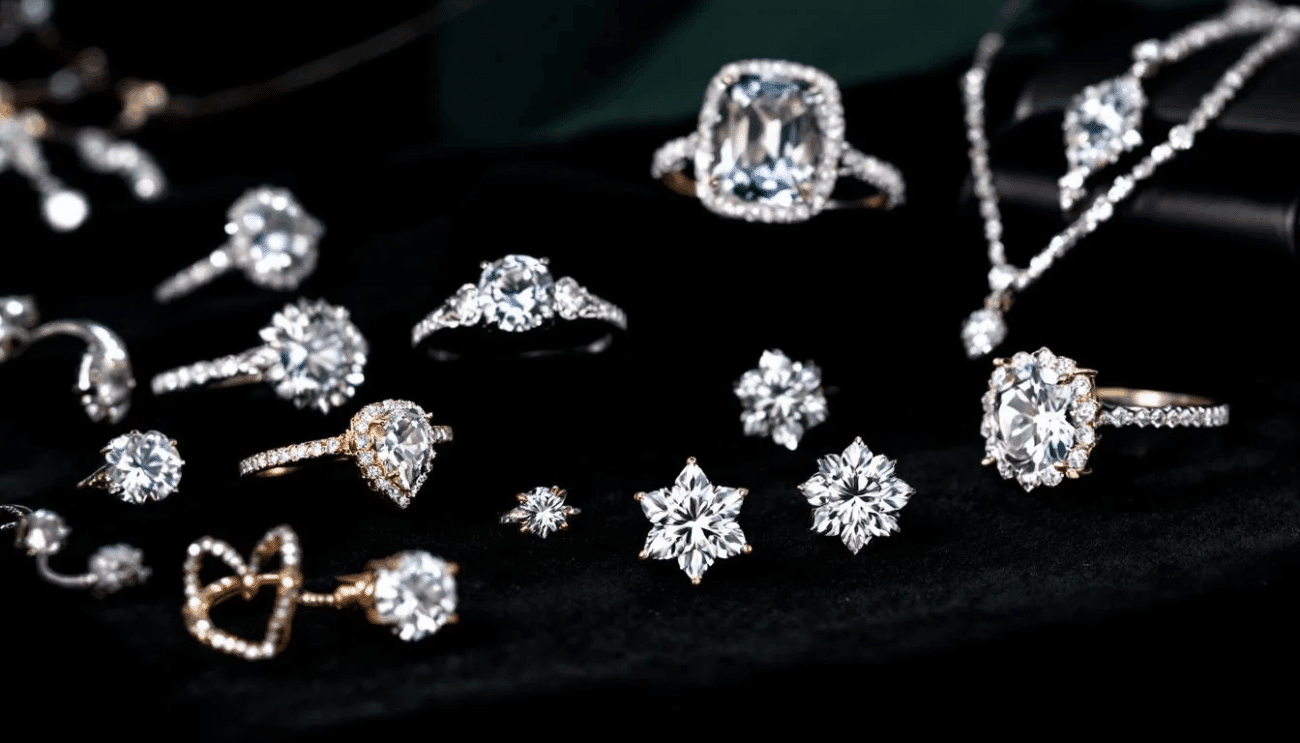Moissanite vs Cubic Zirconia: Complete Comparison Guide 2025
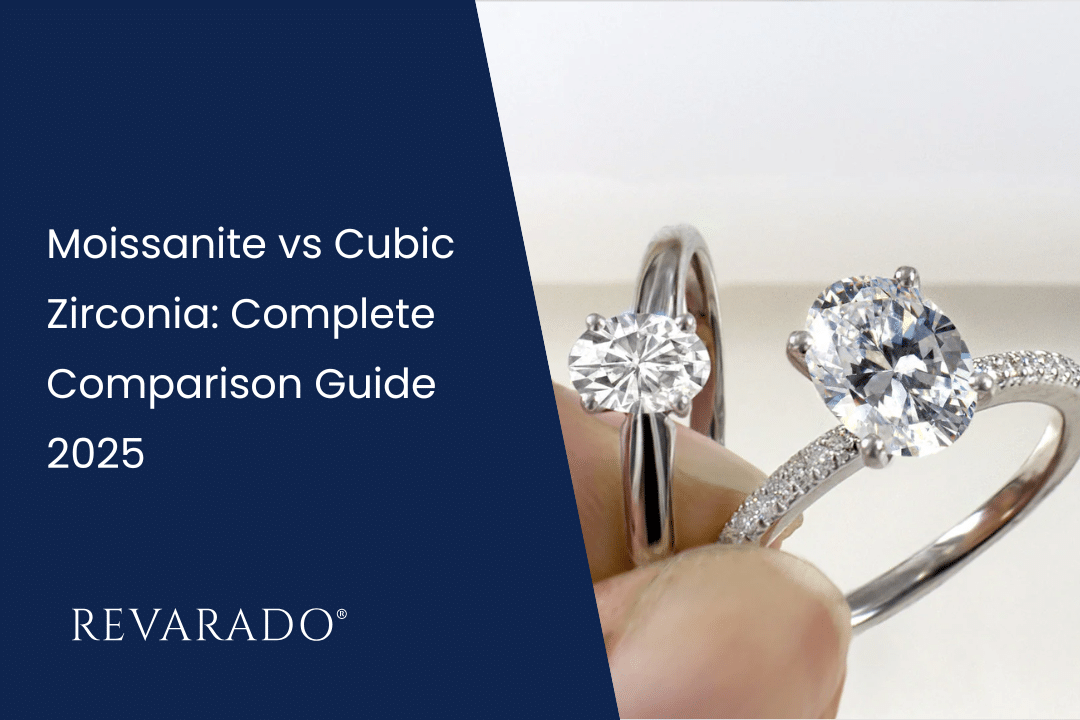
When shopping for diamond alternatives, two names consistently dominate the conversation: moissanite and cubic zirconia. Both stones offer the diamond like appearance that many desire, but they differ dramatically in composition, durability, and long-term value. Moissanite and cubic zirconia are a popular choice among those seeking diamond alternatives due to their affordability and visual appeal. Whether you’re considering an engagement ring or everyday jewelry, understanding these differences is crucial for making an informed decision.
This comprehensive guide breaks down everything you need to know about these popular diamond simulants, from their chemical composition to real-world performance. By the end, you’ll have the knowledge to choose the stone that best matches your needs, budget, and lifestyle.
Quick Comparison Overview
When considering cubic zirconia vs moissanite, the main difference lies in their fundamental composition and resulting properties. Moissanite is composed of silicon carbide, while cubic zirconia is composed of zirconium dioxide. This difference in what each stone is composed of leads to variations in brilliance, hardness, and overall performance. Moissanite offers exceptional brilliance and a 9.25 Mohs hardness rating, while cubic zirconia provides good sparkle and an 8-8.5 Mohs hardness.
Here’s a side-by-side comparison of the key differences:
| Property | Moissanite | Cubic Zirconia |
|---|---|---|
| Composition | Silicon carbide (SiC) | Zirconium dioxide (ZrO₂) |
| Hardness (Mohs Scale) | 9.25 | 8-8.5 |
| Refractive Index | 2.65-2.69 | 2.15-2.18 |
| Dispersion | 0.104 | 0.058-0.066 |
| Density | 3.2 g/cm³ | 5.6-6.0 g/cm³ |
| Price per Carat | ~$400 | $20-$40 |
| Durability | Excellent for everyday wear | Good for occasional wear |
| Fire/Rainbow Flashes | Exceptional | Moderate |
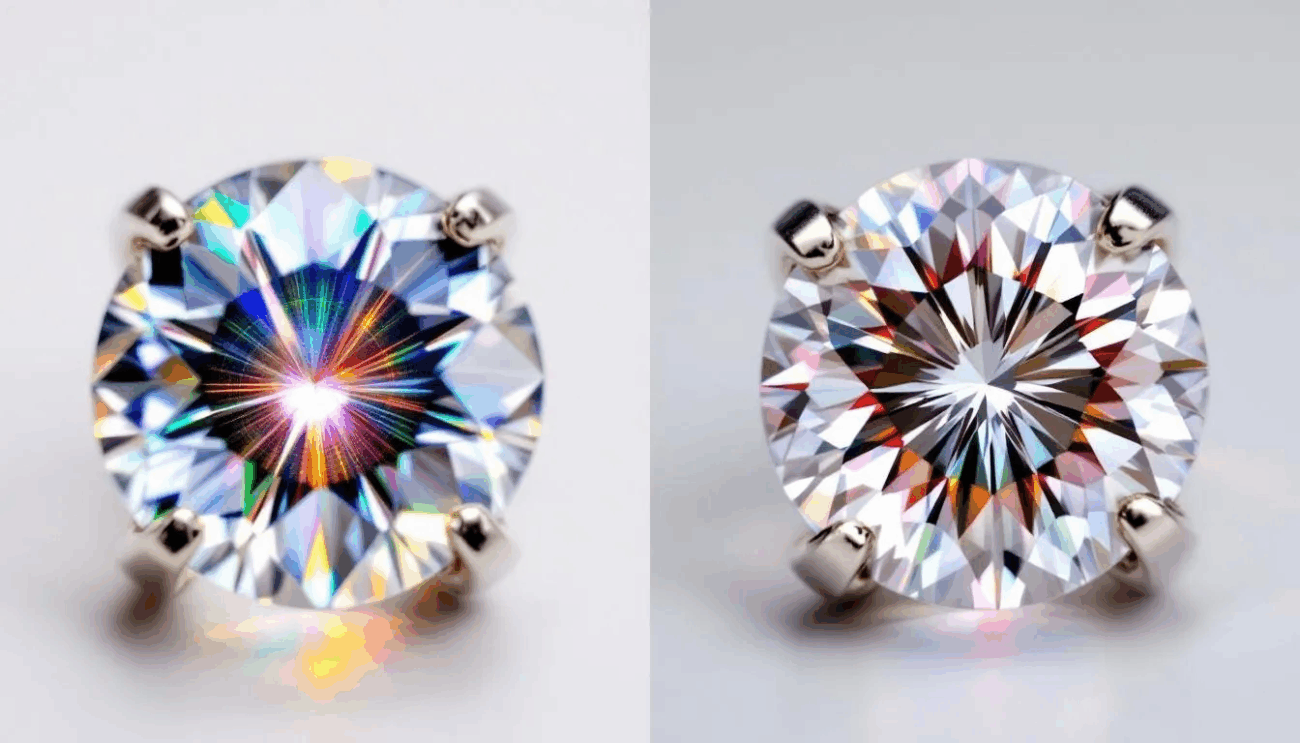
Material Composition and Origins
Understanding the fundamental composition of these diamond substitutes reveals why they perform so differently in real-world applications.
Moissanite’s Unique Origins
Natural moissanite was first discovered in 1893 by French chemist Henri Moissan in an Arizona meteorite crater. This silicon carbide compound proved to be extremely rare on Earth, found primarily in meteorite fragments and some volcanic rocks. The natural form is so scarce that virtually all moissanite used in jewelry today is laboratory-created.
Commercial moissanite production began in the 1990s when researchers developed techniques to grow silicon carbide crystals in controlled laboratory environments. This synthetic process creates stones that are chemically identical to the rare natural moissanite found in space.
Cubic Zirconia’s Synthetic Heritage
Unlike moissanite, cubic zirconia has no natural counterpart used in the jewelry industry. This zirconium dioxide compound was first synthesized commercially by Soviet scientists in 1976 as part of laser technology research. The breakthrough came when researchers discovered they could create large, clear crystals suitable for gemstone applications.
Since its introduction to the jewelry market in the late 1970s, cubic zirconia has become the most widely used diamond simulant due to its affordability and ease of production. The entire cubic zirconia jewelry market relies on synthetic manufacturing processes.
These chemical differences between silicon carbide and zirconium dioxide directly impact every aspect of performance, from durability to brilliance to long-term value retention.
Durability and Hardness Comparison
When evaluating stones for engagement rings or everyday jewelry, durability becomes the most critical factor for long-term satisfaction. Moissanite is considered more durable than cubic zirconia, making it a better choice for long-term wear.
In summary, moissanite’s higher durability gives it an edge over cubic zirconia for those seeking longevity in their jewelry.
Moissanite’s Superior Hardness
On the Mohs scale, moissanite rates 9.25, making it the second-hardest gemstone after natural diamond. This high hardness means moissanite resists scratching from virtually all materials encountered in daily life. The stone maintains its polish and clarity even after years of continuous wear.
Beyond surface hardness, moissanite demonstrates exceptional toughness at 7.6 PSI, meaning it resists chipping and breaking under impact. This combination of hardness and toughness makes moissanite highly resistant to the wear patterns that commonly affect other gemstones.
Cubic Zirconia’s Moderate Durability
Cubic zirconia depends on its 8-8.5 Mohs rating for scratch resistance, which provides good protection against most everyday hazards. However, this lower hardness makes CZ more vulnerable to surface abrasions from materials like sand, concrete, and even some metal jewelry settings.
The toughness rating of 2.4 PSI means cubic zirconia is approximately three times more likely to chip or crack compared to moissanite. This lower durability becomes apparent within months of regular wear, as CZ stones often develop surface cloudiness and small scratches that diminish their sparkle.
Real-World Performance
For engagement rings and daily jewelry, these durability differences translate into vastly different lifespans. Moissanite maintains its appearance for decades with minimal care, while cubic zirconia typically shows visible wear within 6-12 months of regular use. This durability gap explains why jewelers recommend moissanite for pieces intended for everyday wear.
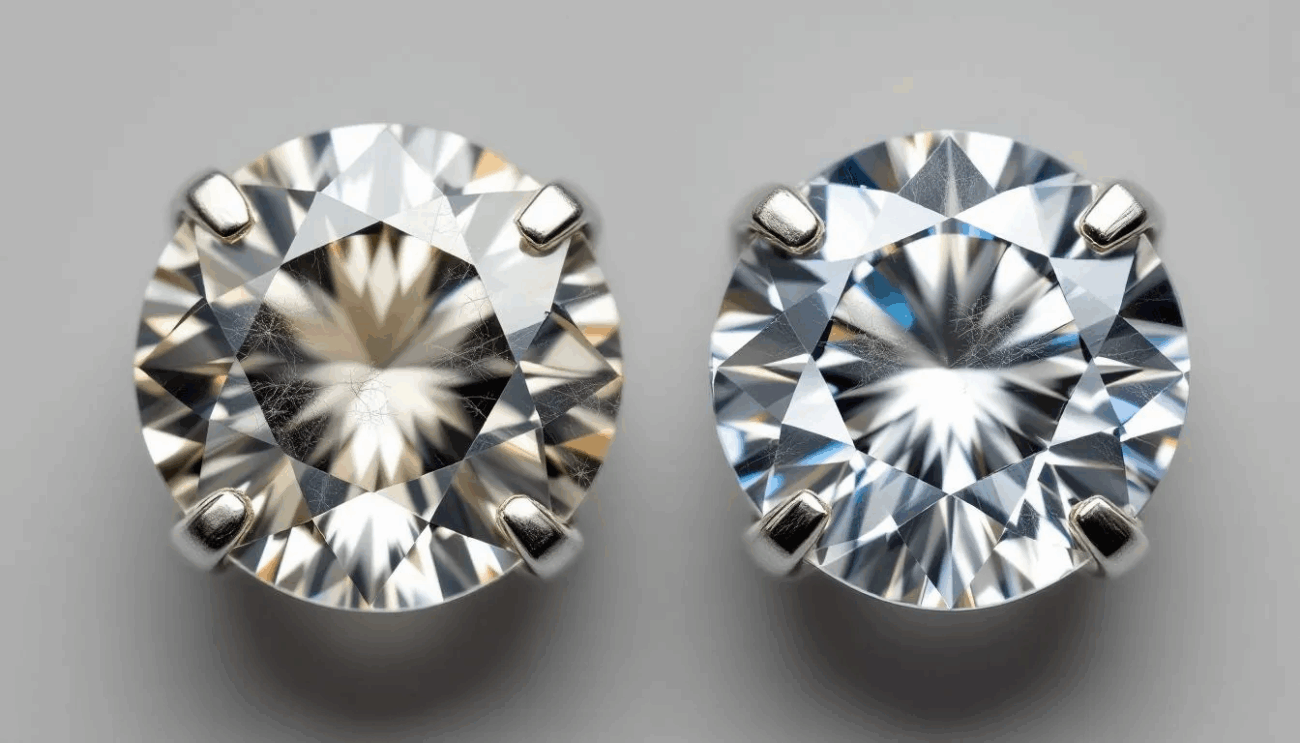
Brilliance and Optical Properties
The optical performance of these diamond alternatives determines how closely they match the light behavior that makes diamonds so desirable. Moissanite’s higher refractive index is a key factor in its exceptional brilliance and fire, setting it apart from other gemstones.
In summary, moissanite’s scintillation—the way it sparkles and flashes under light—is superior to that of cubic zirconia.
Moissanite’s Exceptional Light Performance
Moissanite’s higher refractive index of 2.65-2.69 creates greater brilliance than both cubic zirconia and natural diamonds. This doubly refractive property means light entering the stone splits into two rays, creating the intense sparkle that characterizes quality moissanite.
The dispersion rating of 0.104 gives moissanite more fire than any other commonly used gemstone. This creates the rainbow flashes that many consider moissanite’s signature characteristic – producing 58% more colorful light displays compared to cubic zirconia.
Cubic Zirconia’s Solid Brilliance
With a refractive index of 2.15-2.18, cubic zirconia offers brilliant white light reflection that closely mimics diamond behavior. As a singly refractive material, CZ keeps incoming light in a single ray, creating clean, bright sparkle without the intense fire of moissanite.
The dispersion of 0.058-0.066 produces moderate rainbow flashes – more than natural diamonds but significantly less than moissanite. This makes cubic zirconia an excellent choice for those who prefer subtle light play over dramatic fire effects.
Heat Resistance Considerations
Moissanite demonstrates remarkable heat resistance, actually surpassing natural diamonds in thermal stability. This property allows jewelers to perform repairs and resizing without risk of stone damage. Cubic zirconia shows greater sensitivity to thermal shock and may crack under rapid temperature changes during jewelry repair processes.
These optical differences mean choosing between stones often comes down to personal preference for light behavior – those who love intense fire typically prefer moissanite, while those seeking subtle elegance often choose cubic zirconia.
Cost and Value Analysis
Understanding the pricing structure and long-term value proposition helps determine which stone offers the better investment for your specific needs.
Current Market Pricing
Cubic zirconia jewelry represents the most affordable entry point into diamond-like appearance. Standard CZ pieces typically range from $20-$100, with higher-quality settings and larger stones reaching the upper end of this range. This pricing makes cubic zirconia accessible to virtually any budget.
Comparable moissanite jewelry ranges from $200-$800 depending on stone size, cut quality, and setting materials. While this represents a significant premium over cubic zirconia, it remains dramatically less expensive than equivalent natural diamonds, which would cost thousands for similar sizes.
Production Cost Factors
The price difference reflects fundamental differences in production complexity. Cubic zirconia offers simple, high-volume manufacturing that keeps costs minimal. The zirconium dioxide can be produced quickly in large quantities with consistent quality.
Moissanite production requires more sophisticated crystal growth techniques and longer processing times. The silicon carbide must be grown under precise conditions to achieve the optical clarity and structural integrity that characterizes quality moissanite.
Long-Term Value Considerations
When evaluating total cost of ownership, replacement frequency becomes crucial. Cubic zirconia typically requires replacement every 1-2 years with regular wear due to surface degradation and loss of sparkle. Moissanite maintains its appearance for decades, making the higher upfront cost more economical over time.
Neither stone retains significant resale value compared to natural diamonds. However, moissanite holds its value better than cubic zirconia in secondary markets, though buyers should not expect either stone to function as an investment vehicle.
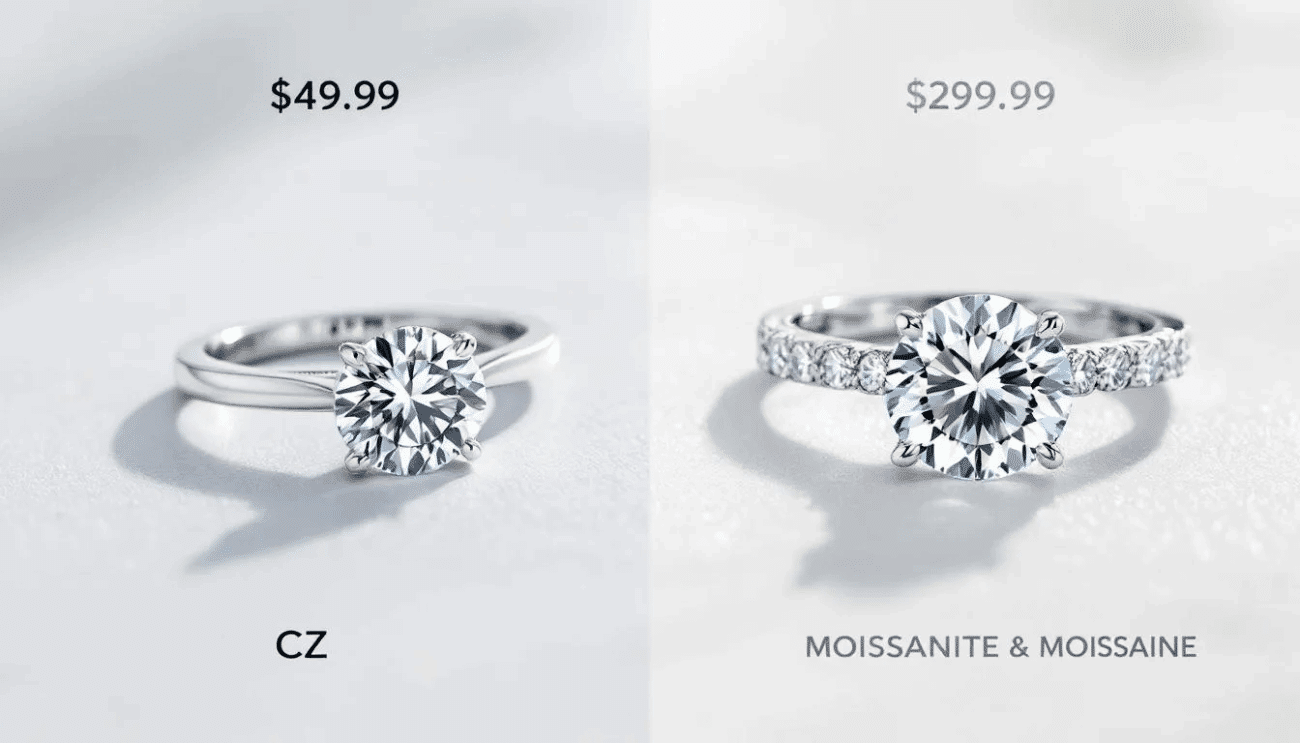
Appearance and Color Options
The visual characteristics and available color ranges determine how well each stone meets specific aesthetic preferences and design requirements. Inclusions, or internal features, can also affect appearance: moissanite may display pipelike inclusions under magnification, while cubic zirconia typically appears clearer.
Moissanite’s Diamond-Focused Approach
Moissanite manufacturers concentrate on creating colorless and near-colorless stones that closely match the appearance of high-grade natural diamonds. The most popular options include completely colorless varieties that eliminate any hint of yellow or gray tinting.
Near-colorless moissanite options provide subtle warmth that many find appealing in yellow gold settings. Some specialty cuts offer faint color tints, but the market primarily demands diamond-like clarity and neutrality for engagement ring applications.
The fiery rainbow flashes characteristic of moissanite become more pronounced in larger stones. While some customers love this dramatic light play, others prefer smaller stones where the fire appears more subtle and diamond-like.
Cubic Zirconia’s Color Versatility
Cubic zirconia offers the broadest color spectrum of any diamond alternative. Beyond colorless options, CZ is readily available in vibrant blues, pinks, greens, yellows, and virtually any color imaginable. This versatility makes CZ popular for fashion jewelry and creative design applications.
The extensive color range results from the ease of introducing different elements during the manufacturing process. Cubic zirconia can achieve color saturation levels impossible in natural gemstones, allowing for bold, eye-catching pieces.
For those seeking traditional diamond appearance, high-quality colorless cubic zirconia provides excellent visual similarity to natural diamonds, especially in smaller sizes where optical differences become less apparent.
Fluorescence and UV Response
Both stones exhibit different fluorescence patterns under ultraviolet light. Moissanite typically shows minimal fluorescence, maintaining consistent appearance in all lighting conditions. Some cubic zirconia varieties display noticeable fluorescence that can affect appearance under certain lighting, though this varies by manufacturing source.
Care and Maintenance Requirements
Proper care extends the lifespan and maintains the appearance of both stones, though their different hardness levels require adjusted approaches.
Universal Cleaning Methods
Both moissanite and cubic zirconia respond well to gentle cleaning with mild dish soap, warm water, and a soft brush. This basic approach removes oils, lotions, and everyday buildup that can dull the stones’ sparkle. Ultrasonic cleaners work safely for both materials when used according to manufacturer guidelines.
Avoid harsh chemicals, bleach, and abrasive cleaners that can damage stone surfaces or metal settings. Steam cleaning works well for both stones, though professional cleaning ensures optimal results without risk of damage.
Moissanite’s Low-Maintenance Advantage
The superior hardness of moissanite means it requires minimal special care beyond regular cleaning. The stone resists clouding and maintains its polish indefinitely with normal use. Monthly cleaning typically suffices to keep moissanite looking its best.
Storage presents few concerns for moissanite due to its scratch resistance. The stone can be stored with other jewelry without risk of surface damage, though proper organization still protects metal settings and prevents tangling.
Cubic Zirconia’s Enhanced Care Needs
Cubic zirconia benefits from more frequent cleaning due to its tendency to show surface buildup more readily. Weekly cleaning helps maintain optimal sparkle, especially for pieces worn daily. The stone’s lower hardness makes it more susceptible to gradual dulling from accumulated microscopic scratches.
Storage requires more attention to prevent contact with harder materials that could scratch the CZ surface. Separate pouches or compartments protect cubic zirconia from damage while maintaining organization.
Professional Maintenance
Professional cleaning and inspection benefit both stones, though for different reasons. Moissanite typically needs only annual professional attention to check settings and ensure mounting security. Cubic zirconia may benefit from professional polishing every 6-12 months to restore optimal surface condition and remove accumulated wear patterns.
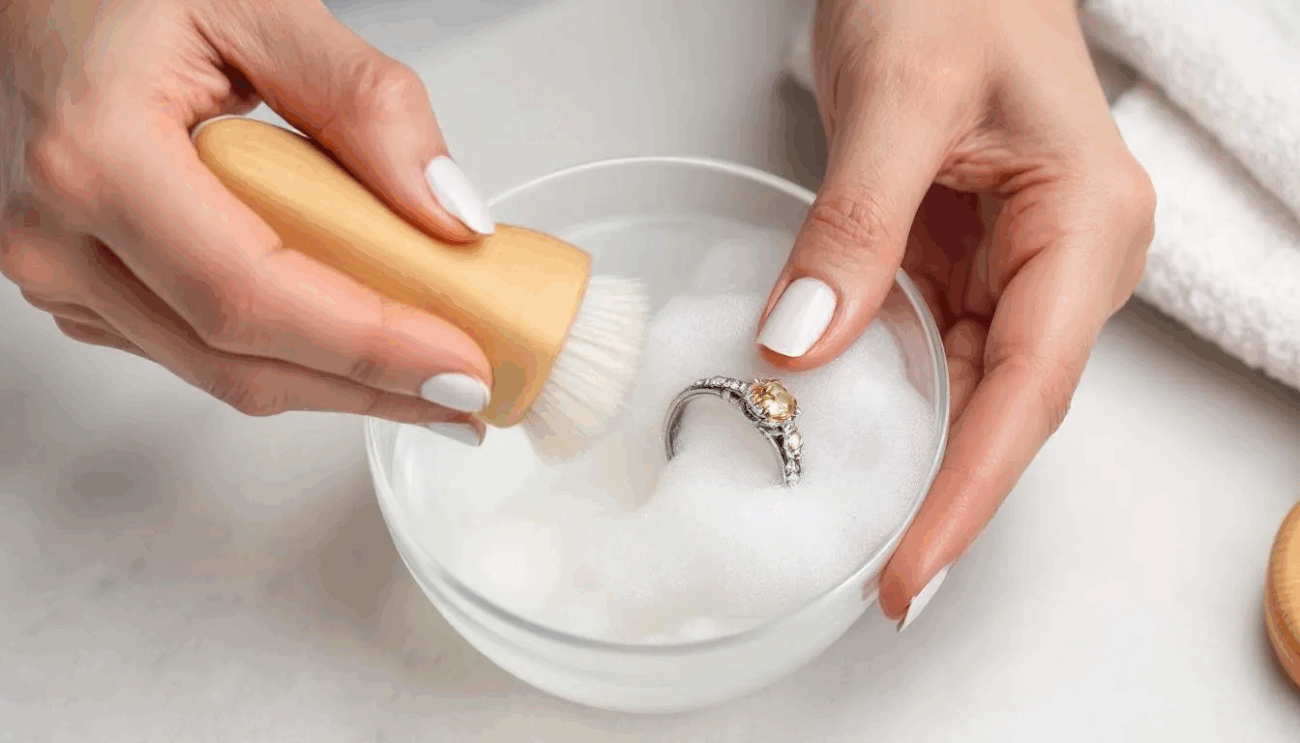
Testing and Identification Methods
Accurate identification becomes important for insurance, resale, and verification purposes, though the methods differ significantly between these diamond alternatives. Traditional diamond testers are specifically designed to identify a real diamond, distinguishing it from simulants like moissanite and cubic zirconia.
Basic Thermal Testing
Traditional diamond testers rely on thermal conductivity to distinguish real diamonds from simulants. These devices easily identify cubic zirconia as non-diamond due to CZ’s different heat conduction properties. The test provides immediate, definitive results for cubic zirconia identification.
Moissanite presents a more complex testing challenge because its thermal conductivity closely resembles that of natural diamonds. Basic diamond testers often register moissanite as diamond, requiring more sophisticated equipment for accurate identification.
Advanced Testing Methods
Specialized moissanite testers use electrical conductivity rather than thermal properties to distinguish between moissanite and natural diamonds. These devices provide accurate identification by measuring how each material conducts electricity – moissanite conducts electricity while diamonds do not.
Professional gemological testing offers the most comprehensive identification through multiple measurement techniques. GIA and other certified laboratories can definitively identify both stones through refractive index measurement, specific gravity testing, and spectral analysis.
Visual Identification Techniques
Experienced jewelers can often identify these stones through careful visual examination. Moissanite’s intense fire and rainbow flashes provide visual clues, especially in larger stones where the optical effects become more pronounced. The doubly refractive nature creates distinctive light patterns visible under magnification.
Cubic zirconia typically displays a slightly different luster quality compared to diamonds or moissanite. The singly refractive nature and lower dispersion create recognizable light patterns for trained observers, though visual identification requires significant experience.
Weight and Density Differences
The different densities allow for identification through precise weight measurement. Cubic zirconia’s higher density (5.6-6.0 g/cm³) makes CZ stones noticeably heavier than moissanite or diamonds of the same size. This weight difference provides a simple identification method when exact measurements are available.
Which Stone Should You Choose?
The decision between moissanite and cubic zirconia ultimately depends on your priorities regarding cost, durability, and intended use. When comparing cubic zirconia moissanite, it’s important to note that moissanite offers greater durability and brilliance, while cubic zirconia is more affordable but less resilient and sparkly. Understanding your specific needs helps determine which stone provides the better value proposition.
Choose Cubic Zirconia When…
Cubic zirconia represents the ideal choice for budget-conscious buyers who want immediate diamond-like appearance without long-term durability concerns. Fashion jewelry, cocktail rings, and pieces intended for occasional wear benefit from CZ’s affordability and extensive color options.
Travelers often prefer cubic zirconia for vacation jewelry since the low replacement cost eliminates concerns about loss or damage. The stone works well for trying new styles or following fashion trends without significant financial commitment.
For those who frequently update their jewelry collection or prefer variety over longevity, cubic zirconia’s low cost enables experimentation with different looks and settings. The extensive color range supports creative designs impossible with more expensive alternatives.
Select Moissanite When…
Moissanite becomes the superior choice for long-term jewelry investments, particularly engagement rings and pieces intended for daily wear. The exceptional durability ensures decades of maintained appearance, making the higher upfront cost economical over time.
Those who prioritize exceptional brilliance and fire often prefer moissanite’s intense light performance over the more subtle sparkle of other alternatives. The unique optical properties create a distinctive appearance that many find more appealing than traditional diamond simulants.
Quality-conscious buyers who want “real” gemstone properties rather than synthetic substitutes appreciate moissanite’s superior hardness and genuine mineral composition. The stone provides authentic gemstone characteristics at a fraction of natural diamond costs.
Lifestyle Considerations
Active lifestyles benefit from moissanite‘s superior durability and resistance to damage from impacts and abrasions. Those working with their hands or participating in sports find moissanite maintains its appearance despite challenging conditions.
For formal or professional settings where understated elegance is preferred, either stone can work depending on personal taste. Moissanite’s fire appeals to those who enjoy attention-getting sparkle, while cubic zirconia’s subtle brilliance suits those preferring classic elegance.
Budget Planning Strategies
Consider total cost of ownership when comparing options. While cubic zirconia offers lower upfront costs, frequent replacement needs may make moissanite more economical for long-term wear. Calculate replacement cycles based on your wearing frequency and care habits.
For engagement rings specifically, most jewelers recommend moissanite due to the symbolic importance and daily wear requirements. The investment in greater durability pays dividends in maintained appearance and reduced replacement needs over decades of wear.
The choice between these diamond alternatives reflects personal priorities and intended use patterns. Both stones serve specific needs effectively when properly matched to buyer expectations and usage requirements. Understanding these differences ensures satisfaction with your selection regardless of which stone you ultimately choose.
